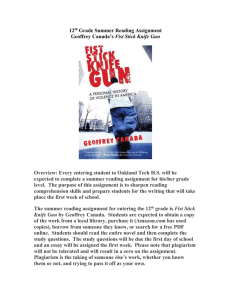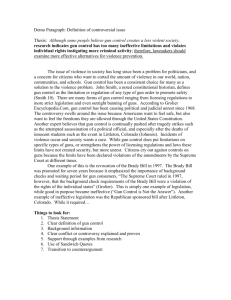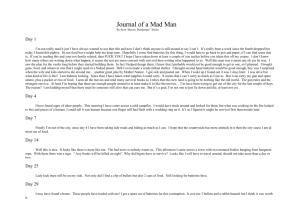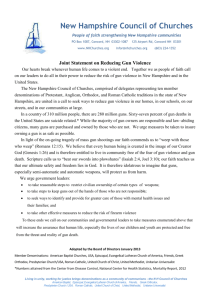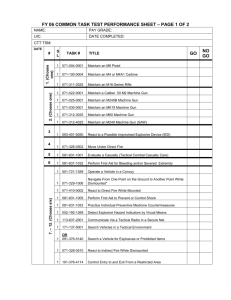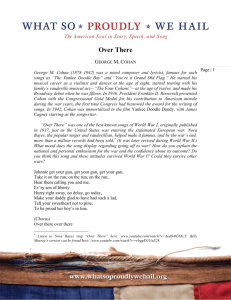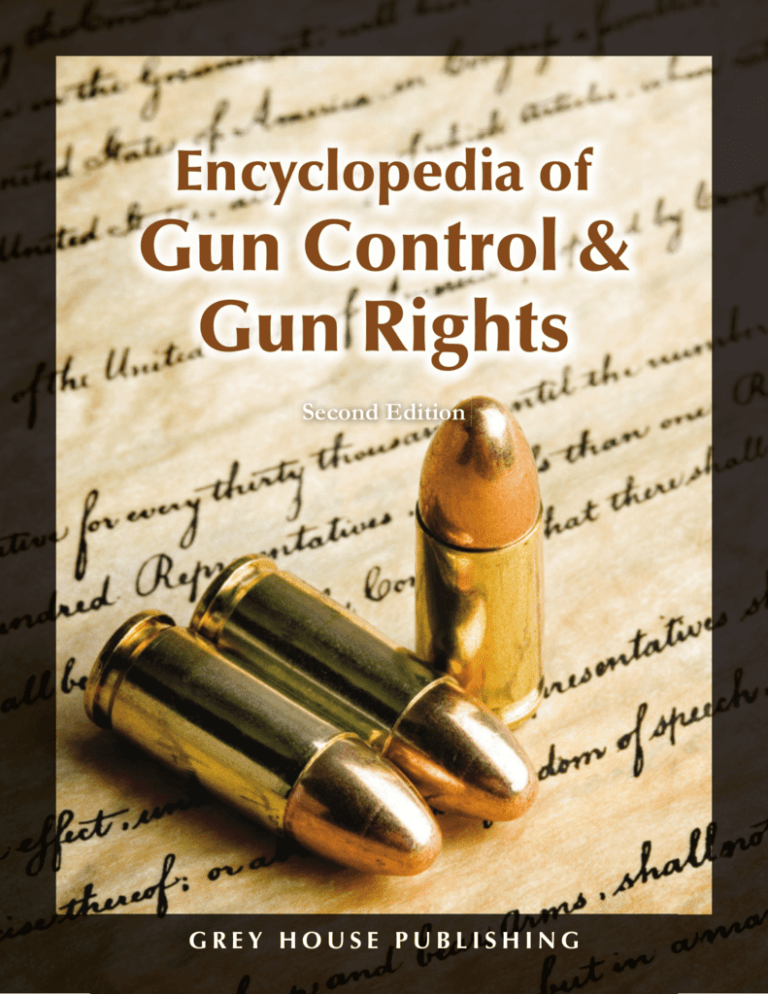
Encyclopedia of
Gun Control &
Gun Rights
Second Edition
GREY HOUSE PUBLISHING
PUBLISHER:
EDITORIAL DIRECTOR:
EDITORIAL ASSISTANT:
PRODUCTION MANAGER:
MARKETING DIRECTOR:
AUTHORS:
COPYEDITOR:
COMPOSITION:
Leslie Mackenzie
Laura Mars
Diana Delgado
Kristen Thatcher
Jessica Moody
Robert J. Spitzer, Glenn H. Utter
Marguerite Duffy
DWJ BOOKS LLC
Grey House Publishing, Inc.
4919 Route 22
Amenia, NY 12501
518.789.8700 FAX 845.373.6390
www.greyhouse.com
e-mail: books@greyhouse.com
While every effort has been made to ensure the reliability of the information presented in this publication,
Grey House Publishing neither guarantees the accuracy of the data contained herein nor assumes any responsibility
for errors, omissions or discrepancies. Grey House accepts no payment for listing; inclusion in the publication
of any organization, agency, institution, publication, service or individual does not imply endorsement of the
editors or publisher.
Errors brought to the attention of the publisher and verified to the satisfaction of the publisher will be corrected
in future editions.
Except by express prior written permission of the Copyright Proprietor no part of this work may be copied by any
means of publication or communication now known or developed hereafter including, but not limited to, use in any
directory or compilation or other print publication, in any information storage and retrieval system, in any other
electronic device, or in any visual or audio-visual device or product.
This publication is an original and creative work, copyrighted by Grey House Publishing, Inc. and is fully
protected by all applicable copyright laws, as well as by laws covering misappropriation, trade secrets
and unfair competition.
Grey House has added value to the underlying factual material through one or more of the following efforts:
unique and original selection; expression; arrangement; coordination; and classification.
Publisher’s Cataloging-In-Publication Data
(Prepared by The Donohue Group, Inc.)
Utter, Glenn H.
Encyclopedia of gun control and gun rights / Glenn H. Utter [and] Robert J. Spitzer.—2nd ed.
p. : ill. ; cm.
Includes bibligraphical references and index.
ISBN: 978-1-59237-672-8
1. Firearms—Law and legislation—United States—Encyclopedias.
2. Gun control—United States—Encyclopedias. I. Spitzer, Rober J., 1953- II. Title.
KF3941.A68 U88 2011
363363.3/3/0973/03
Copyright © 2011 Grey House Publishing Inc.
Second Edition
All right reserved
Printed in the USA
© 2011 Grey House Publishing
00 Gun Control FM_pi-xxxvi.indd iv
16/05/11 10:23 AM
CONTENTS
Preface ........................................................................................................................ vii
Introductory Essay..................................................................................................... ix
Chronology ............................................................................................................... xxi
Guide to Selected Topics ........................................................................................ xxix
Acknowledgements ............................................................................................... xxxv
Encyclopedia of Gun Control and Gun Rights: A to Z Entries ............................... 1
Primary Documents ................................................................................................ 403
Appendix 1: State Constitutional Gun Rights Provisions ........................................ 515
Appendix 2: Compendium of State Laws Governing Firearms ............................... 519
Appendix 3: List of Organizations ........................................................................... 525
Bibliography ............................................................................................................ 531
Index ......................................................................................................................... 535
© 2011 Grey House Publishing
v
00 Gun Control FM_pi-xxxvi.indd v
16/05/11 10:23 AM
PREFACE
G
un control is a fascinating public policy area that creates extremely emotional reactions
among both those who advocate greater regulation of firearms and those who oppose further
restrictions on ownership and call for the elimination of many existing limitations. The issues
raised in the debate deal with fundamental questions of constitutional law and the rights of individuals,
opportunities for self-protection, the control of violence, and national security. A long-time gun
collector informed one of the authors of an additional factor making this area especially intriguing.
Whenever he displays his gun collection, he can be assured of an attentive audience. Firearms are
inherently interesting. Thousands of firearms fans flood gun shows, admiring the craftsmanship of the
many guns on display and the technological expertise that went into producing them.
Both sides of the gun control debate have their heroes and villains. Many gun rights advocates are
convinced that the Bureau of Alcohol, Tobacco, Firearms, and Explosives (ATF) is a power-hungry
group of government officials intent on limiting the liberties of law-abiding citizens and believe that
the National Rifle Association (NRA) and other gun rights organizations are champions of individual
liberty. Gun control supporters often see gun manufacturers as profit-hungry exploiters of Americans’
fascination with firearms and fear of crime who take advantage of a too ready willingness to settle
disputes violently. They perceive the NRA as a politically ruthless organization, but view the ATF as
a well-intentioned if ineffectual government agency. This book is an attempt to present varying views
on gun rights and gun control, treating all sides of the gun control question as fairly and accurately
as possible.
Gun-related Web sites have proliferated in recent years, contributing greatly to the resources
available on firearms and gun control. These Web sites have been an extremely valuable source of
information in preparing this book. In addition, we consulted a large number of books, periodicals,
and organization literature, as well as the personally expressed views of people on both sides of the
gun control and gun rights issue.
Included among the entries are various organizations that have taken stands on gun control, many
of which are concerned primarily with firearms issues. Many organizations who are on the same side
of the gun control question do not necessarily hold the same views on the issue. Profiles of many
individuals, both inside and outside government, who have promoted or opposed gun control, have
been included, as well as those who have conducted research in the area. We discuss various laws
dealing in some way with gun policy and describe many judicial decisions, at both the national and
state levels, that provide insight into the legal status as well as the cultural ramifications of guns in the
United States. We discuss various events, such as the 1999 Littleton, Colorado, school shooting, the
2007 Virginia Tech University shooting, and the 2011 Tucson shooting. Such events take on special
importance because gun control proponents frequently have mounted campaigns for further firearms
legislation closely following their occurrence. At the same time, gun rights advocates have vigorously
defended firearms ownership, arguing that other factors besides the presence of firearms, such as the
© 2011 Grey House Publishing
00 Gun Control FM_pi-xxxvi.indd vii
vii
16/05/11 10:23 AM
INTRODUCTORY ESSAY
P
erhaps with the exception of abortion, gun control is the most controversial issue in American
politics, appealing strongly to the emotions of those who support, as well as those who oppose,
further regulation of firearms. Although people take many different positions on the issue,
supporting some proposals for control and rejecting others, the more uncompromising on both sides
tend to collapse pro- and anti-gun control categories into two. The pro-gun forces see themselves as
the supporters of a vital constitutional right to keep and bear arms pitted against the “gun grabbers.”
Strong advocates of gun control see themselves struggling for a more civilized society against the “gun
nuts” and profit-hungry firearms manufacturers and dealers. Like many other subjects, the issue of gun
control is preeminently a political question in that the competitors attempting to influence public policy
have an intense interest in the ultimate outcome. Therefore, positions tend to harden and proponents of
one position tend to deny any merit in the stand taken by others, each side attributing dishonest motives
to those with whom they disagree. Scholars who otherwise are meticulous in presenting research
results can become as impassioned in their argumentation as the most openly partisan supporter of a
fervently held political position.
Supporters and opponents of gun control disagree over the significance of firearms as an
independent variable in explaining the high level of violence in the United States. The term “gun
culture” is used by both sides in explaining their respective views of the special role firearms have
played in American history and continue to play in contemporary society. Gun rights advocates point
with pride to the role that average Americans played in the Revolutionary War, especially because of
the skill they reportedly demonstrated with firearms against an intimidated British force. Firearms
are seen as an important ingredient in the unique ability of Americans to maintain their independence
from a potentially oppressive government. Those less impressed with the gun tradition see that the
American love affair with firearms has contributed to a violent past and a continuing belief that the
presence and use of firearms promise to cut cleanly through a quagmire of social problems. While not
denying this predilection for violence, gun supporters note that other cultures not having as extensive a
supply of firearms also experience high levels of violence, that some societies with high concentrations
of firearms have much lower levels of violence, and that the level of violent crime in the United States
did not increase proportionately with a marked increase in the number of firearms available. Gun rights
advocates express their position with the popular saying, “Guns don’t kill people, people kill people,”
and claim that those advocating limitations on firearms suffer from hoplophobia, which is defined as
an irrational and morbid fear of guns. However, Franklin Zimring and Gordon Hawkins have argued
that firearms have had an independent influence on violence in the United States in that the number of
violent crimes that lead to serious injury and death are significantly higher in the United States than
in other countries. Table 1 indicates that the homicide rate is much higher in the United States, where
firearms are easily obtainable, than in England and Wales, where firearms are far less available to the
general public.
© 2011 Grey House Publishing
00 Gun Control FM_pi-xxxvi.indd ix
ix
16/05/11 10:23 AM
CHRONOLOGY
1775
Colonial militia, called the minutemen, defend a store of arms in Lexington,
Massachusetts, against an attempt by British troops under the command of General
Thomas Gage to confiscate weapons. The minutemen take on a reputation far beyond
their contribution to the fight for independence, becoming a crucial ingredient in many
Americans’ positive attitudes toward firearms.
1789
James Madison fulfills a promise to submit 12 constitutional amendments in the first
session of the new House of Representatives; the amendments are to constitute a
Bill of Rights to the recently adopted U.S. Constitution. Although initially holding
that a Bill of Rights is unnecessary, Madison agrees to support the idea to attain
ratification of the Constitution. One of Madison’s proposed amendments originally
reads: “The right of the people to keep and bear arms shall not be infringed; a wellregulated militia being the best security of a free country: but no person religiously
scrupulous of bearing arms shall be compelled to render military service in person.”
The amendment is revised to exclude a religious exemption and is submitted to the
states as: “A well regulated Militia, being necessary to the security of a free State,
the right of the people to keep and bear Arms, shall not be infringed.” This Second
Amendment to the U.S. Constitution is ratified on December 15, 1791.
1792
Congress passes the Militia Act, which establishes an organized militia and an enrolled
militia composed of all free white males, who were expected to provide their own
muskets, firelocks, and ammunition. The act is never truly implemented by the states.
1846
In Nunn v. State, the Supreme Court of Georgia overrules a lower court decision
convicting Hawkins Nunn of carrying a pistol in violation of an 1837 state statute.
The court finds that both the U.S. and Georgia state constitutions guarantee the right
to keep and bear arms and traces the historical roots of the right, calling it “one of the
fundamental principles, upon which rests the great fabric of civil liberty, reared by the
fathers of the Revolution and of the country.”
1857
The U.S. Supreme Court, in Scott v. Sanford, rules that the Bill of Rights does not
apply to blacks. Chief Justice Roger Taney argues that if blacks were given full citizen
status with free white men, they would have the right of free speech and the right “to
keep and carry arms wherever they went.”
1871
Colonel William C. Church and George W. Wingate, former Union army officers,
collaborate in establishing the National Rifle Association (NRA). The NRA hopes to
encourage rifle practice so that Americans will be better prepared militarily for any
future conflict. New York State provides funds to purchase land on Long Island to
establish a rifle range for NRA members.
© 2011 Grey House Publishing
00 Gun Control FM_pi-xxxvi.indd xxi
xxi
16/05/11 10:23 AM
GUIDE TO SELECTED TOPICS
This subject guide arranges this edition’s 338 entries, with page numbers, into the following 16
categories. A number of individuals fall into more than one category.
countries
firearms & ammunition
firearms researchers
groups supporting gun control
gun control issues
historical individuals & groups
individuals supporting gun rights
legislators & government officials
court cases
firearms industry organizations
government agencies & policies
groups supporting gun rights
historical events
individuals supporting gun control
legislation & constitutional amendments
publications
Commonwealth v. Davis (1976) .....................81
Dickerson v. New Banner Institute, Inc.
(1983) .........................................................94
District of Columbia v. Heller (2008) ............95
Farmer v. Higgins (1990) .............................106
Huddleston v. United States (1974)..............154
Kelley v. R.G. Industries, Inc. (1983) ...........174
Lewis v. United States (1980) .......................193
Maryland v. United States (1965) ................203
McDonald v. Chicago (2010) .......................210
Miller v. Texas (1894)...................................221
Muscarello v. United States (1998) ..............227
Nunn v. Georgia (1846)................................253
Perpich v. Department of Defense (1990) .....266
Presser v. Illinois (1886) ..............................273
Printz v. United States (1997) ......................274
Quilici v. Village of Morton Grove (1982) .....280
Schubert v. DeBard (1980) ...........................297
Scott v. Sanford (1857) .................................300
Second Amendment Foundation v. City of
Renton (1983)...........................................305
Sklar v. Byrne (1984) ...................................309
Smith v. United States (1993) .......................314
Sonzinsky v. United States (1937) ................316
Countries
Australia .........................................................26
Canada............................................................64
Israel.............................................................162
Japan ............................................................165
Mexico .........................................................214
Russia ...........................................................290
Switzerland ..................................................336
United Kingdom...........................................353
Court Cases
Armijo v. Ex Cam (1987)................................22
Aymette v. The State (1840) ............................27
Bailey v. United States (1996) ........................31
Barrett v. United States (1976).......................36
Barron v. Baltimore (1833) ............................37
Beecham v. United States (1994) ...................37
Bernethy v. Walt Failor’s Inc. (1978) .............39
Bliss v. Commonwealth (1822) ......................46
Bryan v. United States (1998) ........................58
Caron v. United States (1998) ........................65
Cases v. United States (1942) ........................66
City of Las Vegas v. Moberg (1971) ...............72
City of Salina v. Blaksley (1905) ....................73
© 2011 Grey House Publishing
00 Gun Control FM_pi-xxxvi.indd xxix
xxix
16/05/11 10:23 AM
Aborn, Richard
1
A
Aborn, Richard (1952– )
As president of Handgun Control, Inc.
(HCI) (later renamed the Brady Campaign
to Prevent Gun Violence) and the affiliated
Center to Prevent Handgun Violence (CPHV)
(subsequently renamed the Brady Center to
Prevent Gun Violence) from 1992 to 1996,
Richard Aborn has been an active supporter of
more stringent gun control legislation. Since
1979, Aborn has been involved in the campaign
to reduce gun violence. From 1979 to 1984, he
worked in the Manhattan District Attorney’s
Office, investigating and prosecuting homicide
and illegal gun distribution cases. After leaving
government, Aborn worked as a volunteer for
HCI and was elected to the board of trustees in
1988 and to the presidency in 1992.
Aborn worked to implement CPHV’s STAR
(Straight Talk About Risks) program in New
York City public schools. The program, which is
aimed at children from prekindergarten through
the twelfth grade, is intended to educate youth
about the dangers of firearms to reduce injuries
resulting from their misuse. Aborn contributed
to former New York Governor Mario Cuomo’s
publication project, New York State Strategy to
Reduce Gun Violence. He has been a consultant
to the Ford Foundation on violence and youth
and has worked with a New York task force of
public health officials to consider solutions to
the problem of violent crime.
Aborn has supported passage of a
comprehensive federal gun control bill that
would include licensing and registration of
handgun purchases and transfers, the limitation
of gun purchases to one per month, and a
ban on Saturday night specials. He advocates
a tax on ammunition, dealers’ licenses, and
firearms to be used to pay for the medical
costs of gun-related injuries. He supports the
Brady Campaign position that the organization
does not want to ban all guns or interfere in
the lawful acquisition of firearms, but instead
strives to stop the illegal gun market. Aborn
sees no contradiction between gun ownership
and gun control.
Aborn notes that illicit gun traffickers
acquire firearms in jurisdictions with weak
gun control laws and then sell them illegally
in jurisdictions with more stringent laws.
Aborn holds that Saturday night specials
(which he defines as a handgun that has a
barrel less than two inches long, is made of
nonhomogeneous metal, is unsafe, and cannot
pass a drop test from more than five feet) are
disproportionately used as crime weapons and
have little self-defense use.
Aborn claims that gun control laws already
passed have been effective. He cites a U.S.
Justice Department estimate that the Brady
Handgun Violence Prevention Act, for which he
served as the principal lobbyist, prevented over
70,000 felons from purchasing guns from retail
outlets during the first year after the law went
into effect. In addition, he asserts that the 1994
assault weapons ban, before it expired in 2004,
effectively restricted the supply of such firearms.
In an effort to reassure gun owners that
the Brady Campaign and other organizations
© 2011 Grey House Publishing
01 Gun Control A_p01-29.indd 1
16/05/11 10:24 AM
PRIMARY DOCUMENTS
The 26 original documents in this section are arranged chronologically, and span more than
200 years. They include political debates, court cases, acts of law, and contemporary articles on
both sides of gun control v. gun rights. They are designed to offer an historical reference point
and broader understanding of the complicated issues that surround this ongoing debate.
The Federalist Papers 24 and 25, 1787 .............................................................................................405
Second Amendment Debate Excerpts from the U.S. House of Representatives, 1789 ....................413
The Uniform Militia Act of 1792 ......................................................................................................417
Presser v. Illinois, 1886 .....................................................................................................................421
The Militia Act of 1903.....................................................................................................................427
The National Firearms Act of 1934 ..................................................................................................433
U.S. v. Miller, 1939 ...........................................................................................................................437
The Nobel Uses of Firearms, by Alan Korwin, 2001........................................................................441
The Last Refuge for Hate: Gun Hate, by Alan Korwin, 2005 ..........................................................443
The United Nations and Gun Control, by Marjorie Ann Brown, 2005.............................................445
The Protection of Lawful Commerce in Arms Act of 2005 ..............................................................451
Virginia Tech Tragedy: Analysis of the NICS Improvement Act of 2007 ........................................459
Letter to Acting Secretary Gordon Mansfield from Senator Tom Coburn, 2007 ..............................481
The Tiahrt Amendments, 2007..........................................................................................................483
Who Will Face Down the Gun Lobby?, by E. J. Dionne, Jr.
Washington Post National Weekly Edition April 27-May 3, 2009 ....................................................485
Beyond the NRA’s Absolutism, by E. J. Dionne, Jr. W Washington Post National
Weekly Edition December 21, 2009-January 3, 2010 .......................................................................487
The Supreme Court and Guns: Case for a Scythe?, by Will George
Houston Chronicle March 7, 2010 ....................................................................................................489
© 2011 Grey House Publishing
00.Primary Contents_p403-404.indd 403
403
16/05/11 10:55 AM
APPENDIX 1
State Constitutional Gun Rights Provisions
F
orty-five states have constitutional provisions dealing with the right to keep and bear arms. The
constitutions of five states—California, Iowa, Maryland, Minnesota, and New Jersey—contain
no such provision. The following listing presents the relevant wording of state constitutions.
Alabama: That every citizen has a right to
bear arms in defense of himself and the state
(art. I, para. 26).
Connecticut: Every citizen has a right to
bear arms in defense of himself and the state
(art. I, para. 15).
Alaska: A well-regulated militia being
necessary to the security of a free state, the
right of the people to keep and bear arms shall
not be infringed (art. I, para. 19).
Delaware: A person has the right to keep and
bear arms for the defense of self, family, home
and State, and for hunting and recreational use
(art. I, para. 20).
Arizona: The right of the individual citizen
to bear arms in defense of himself or the
State shall not be impaired, but nothing in
this section shall be construed as authorizing
individuals or corporations to organize,
maintain, or employ an armed body of men
(art. II, para. 26).
Florida: The right of the people to keep and
bear arms in defense of themselves and of
the lawful authority of the state shall not be
infringed, except that the manner of bearing
arms may be regulated by law (art. I, para. 8).
Georgia: The right of the people to keep
and bear arms, shall not be infringed, but
the General Assembly shall have power to
prescribe the manner in which arms may be
borne (art. I, para. I).
Arkansas: The citizens of this State shall
have the right to keep and bear arms for their
common defense (art. II, para. 5).
Colorado: The right of no person to keep and
bear arms in defense of his home, person and
property, or in aid of the civil power when
thereto legally summoned, shall be called in
question; but nothing herein contained shall
be construed to justify the practice of carrying
concealed weapons (art. II, para. 13).
© 2011 Grey House Publishing
52 Gun Control App01_p515-518.indd 515
Hawaii: A well regulated militia being
necessary to the security of a free state, the
right of the people to keep and bear arms shall
not be infringed (art. I, para. 15).
Idaho: The people have the right to keep and
bear arms, which right shall not be abridged;
515
16/05/11 10:47 AM
APPENDIX 2
Compendium of State Laws Governing Firearms
Data on the following pages were compiled by the National Rifle Association’s Institute for Legislative
Action. The NRA-ILA notes that state legislatures and municipal councils have greater policy input
regarding firearm regulations than does the U.S. Congress and cautions gun owners to be aware of laws
and ordinances at the state and local levels. Although the chart presents the major stipulations of state
firearms laws as of 2010, state laws change frequently. Therefore, the data should be regarded neither
as legal advice nor as a completely accurate presentation of the law. In addition to state laws, the
federal Gun Control Act of 1968 and amendments to that legislation contained in the Firearms Owners
Protection Act of 1986 contain provisions regulating the purchase, sale, possession, and interstate
transportation of firearms. Local governments may also have separate firearm ordinances.
© 2011 Grey House Publishing
53 Gun Control App02_p519-524.indd 519
519
16/05/11 10:48 AM
APPENDIX 3
List of Organizations
Listed below are names and contact information of organizations involved in gun rights and gun
control issues.
Academics for the Second Amendment
Joseph E. Olson, President
P.O. Box 131254
St. Paul, MN 55113
Americans for Democratic Action
1625 K Street NW, Suite 102
Washington, DC 20006
(202) 785-5980
www.adaction.org
Amendment II Democrats
http://a2dems.net
Arming Women Against Rape
and Endangerment
P.O. Box 242
Bedford, MA 01730-0242
(781)893-0500
www.aware.org
American Academy of Pediatrics
141 Northwest Point Boulevard
Elk Grove Village, IL 60007-1098
(847) 434-4000
www.aap.org
Association for Women’s Self-Defense
Advancement
556 Route 17 North, Suite 7-209
Paramus, NJ 07652
(201) 794-2153
www.awsda.org
American Bar Association
321 North Clark Street
Chicago, IL 60654-7598
(312) 988-5000
www.abanet.org
American Civil Liberties Union
125 Broad Street, 18th Floor
New York, NY 10004-2400
www.aclu.org
British American Security
Information Council
110 Maryland Avenue NW, Suite 205
Washington, DC 20002
(202) 546-8055
www.basicint.org
American Jewish Congress
115 57th Street, Suite 11
New York, NY 10022
(212) 879-4500
www.ajcongress.org
525
© 2011 Grey House Publishing
54 Gun Control App03_p525-530.indd 525
16/05/11 10:48 AM
BIBLIOGRAPHY
Ahern, Jerry. CCW: Carrying Concealed Weapons, How to Carry Concealed Weapons and Know When Others Are. Chino
Valley, AZ: Blacksmith Corp., 1996.
Anderson, Jack. 1996. Inside the NRA. Beverly Hills, CA: Dove Books.
Apel, Lorelei. Dealing with Weapons at School and at Home. New York: Rosen Publishing Group, 1996.
Ayoob, Massad F. In the Gravest Extreme: The Role of the Firearm in Personal Protection. Concord, NH: Police
Bookshelf, 1980.
________. Gunproof Your Children: Handgun Primer. Concord, NH: Police Bookshelf, 1986.
Bartone, John C. Guns, the National Rifle Association, and Consumers as Armed Citizens. Washington, DC: ABBE, 1994.
________. Guns and Their Importance to Americans Facing Crimes of Threat, Harm, and Property Invasion. Washington,
DC: ABBE, 1996.
Beckelman, Laurie. Gun Control: You Decide. Parsippany, NJ: Crestwood House, 1999.
Bellesiles, Michael. Arming America: The Origins of a National Gun Culture. New York: Alfred A. Knopf, 2000.
Berands, Neal. Gun Control. San Diego: Lucent Books, 1992.
Bijlefeld, Marjolijn. Gun Control Debate: A Documentary History. Westport, CT: Greenwood, 1997.
Bird, Chris. The Concealed Handgun Manual: How to Choose, Carry, and Shoot a Gun in Self Defense. San Antonio:
Privateer Publications, 1998.
Bogus, Carl T., ed. The Second Amendment in Law and History. New York: New Press, 2002.
Brennan, Jill W. Gun Control in the 1990s. Kettering, OH: PPI, 1996.
Brown, Peter Harry, and Daniel G. Abel. 2003. Outgunned: Up Against the NRA. New York: The Free Press.
Bruce, John M. and Clyde Wilcox, eds. The Changing Politics of Gun Control. Lanham, MD: Rowman and Littlefield, 1998.
Burbick, Joan. Gun Show Nation: Gun Culture and American Democracy. New York: The New Press, 2006.
Bureau of Alcohol, Tobacco, and Firearms. Federal Firearms Regulations Reference Guide. Washington, DC: U.S.
Government Printing Office, 1995.
________. State Laws and Published Ordinances_Firearms, 21st ed. Washington, DC: U.S. Government Printing
Office, 1998.
Carter, Gregg Lee. The Gun Control Movement. New York: Twayne, 1997.
________, ed. Encyclopedia of Guns in American Society. 2 vols. Santa Barbara, CA: ABC-CLIO, 2003.
Charles, Patrick J. The Second Amendment: The Intent and Its Interpretation by the States and the Supreme Court. Jefferson,
NC: McFarland, 2009.
Cook, Philip, and Jens Ludwig. Gun Violence: The Real Costs. New York: Oxford University Press, 2000.
Cornell, Saul. Whose Right to Bear Arms Did the Second Amendment Protect? Boston: Bedford/St. Martin’s, 2000.
________. A Well Regulated Militia. New York: Oxford University Press, 2006
Cottrol, Robert J., ed. Gun Control and the Constitution: Sources and Explorations on the Second Amendment. New York:
Garland, 1994.
Cox, Vic. Guns, Violence and Teens. Enslow, 1997.
Cozic, Charles P. The Militia Movement. San Diego: Greenhaven, 1997.
Cozic, Charles P., and Carol Wekesser, eds. Gun Control. San Diego: Greenhaven, 1992.
Cullen, Dave. Columbine. New York: Twelve, 2009.
Davidson, Osha Gray. Under Fire: The NRA and the Battle for Gun Control. Iowa City: University of Iowa Press, 1998.
DeConde, Alexander. Gun Violence in America. Boston: Northeastern University Press 2001.
© 2011 Grey House Publishing
55 Gun Control Bib_p531-534.indd 531
531
16/05/11 10:48 AM
INDEX
Aborn, Richard, 1-2
Abrams, Sandy, 149
Academics for the Second
Amendment (ASA), 2-3
Accidents, 148, 245
Accidents involving guns, 3-5,
148, 245
children and, 4
Adjutant general, of militias, 218
African Americans, 2, 5-6
firearm fatalities and, 107
limitations on gun rights, 118
post-Civil War, 182
AK-47, 6-7, 51, 286, 287
use in a shooting incident, 327
AKM. See AK-47
Alaskan Independence
Party, 263
Alcohol and Tobacco Tax and
Trade Bureau, 59
Alemany, Joseph Sadoc, 101
Alfred P. Murrah Federal
Building, 256
Aliens, 7-8
Alito, Samuel, 210
Allen, Steve, 50
Alliant Techsystem, 140
Almost Heaven community, 124
Altria, 147
Ambiguity of intent
hypothesis, 158
Amendment II Democrats, 8-9
America Fights Back: Armed
Self-Defense in a Violent Age
(book), 72
America in Peril (video), 217
American Academy of Child and
Adolescent Psychiatry, 277
American Academy of Pediatrics
(AAP), 9-11, 150, 277, 330
© 2011 Grey House Publishing
56 Gun Control Index_p535-550.indd 535
American Association of Public
Health Physicians, 277
American Bar Association (ABA),
11-12
Standing Committee on Gun
Violence, 11
Special Committee on Gun
Violence, 11
American Civic Association,
Binghamton, New York, 40, 41
American Civil Liberties Union
(ACLU), 12-13, 85, 176
and the Second Amendment, 12
criticism of, 214
American College of Physicians, 150
American Conservative Union, 34,
110, 122, 207
American Federation of Teachers,
330, 331
American Firearms Council, 135
American Firearms Industry
(periodical), 229
American Firearms Institute
(AFI), 13-14
American Game Association, 109
American Handgun Standards
Act, 49
American Handgunner Award
Foundation, 123
American Hunter (periodical),
28, 35
American Hunters and Shooters
Association, endorsement of
Barack Obama, 256
American Jewish Congress (AJC),
14-15
American Justice Federation, 342
American Legion, 109
American Medical
Association, 150
The American Patriot
(periodical), 224
American Public Health
Association, 277
American Revolution, 15-17, 127,
224-25, 323
American Rifleman (periodical),
17-18, 35, 138, 139, 153,
180, 289
anecdotes on self-defense, 307
American Shooting Sports Council
(ASSC), 18-19, 135, 248, 347
American Society for Law
Enforcement Trainers, 28
American Society of
Criminology, 178
American Wildlife Institute, 109
Americans for Democratic Action
(ADA), 19-20, 110
Americans for Gun Safety, 341
Americans for Safe Streets
(AUSS), 20-21
Americas Regional Workshop on
Firearm Regulation, 19
Amicus curiae briefs, 304
Amnesty International, 215
Amoco, 147
Anderson, Casey, 78
Anderson, Robyn, 136
Andrews, John, 156
Angle, Sharron, 149
Anti-Defamation League, 167, 220
Antiterrorism and Effective Death
Penalty Act, 21-22
authorization of taggant study, 339
Armed and Alive (book), 307
Armed Informed Mothers
March, 222
Armed People Victorious (book), 271
Armijo, Dolores, 22
535
16/05/11 10:48 AM


